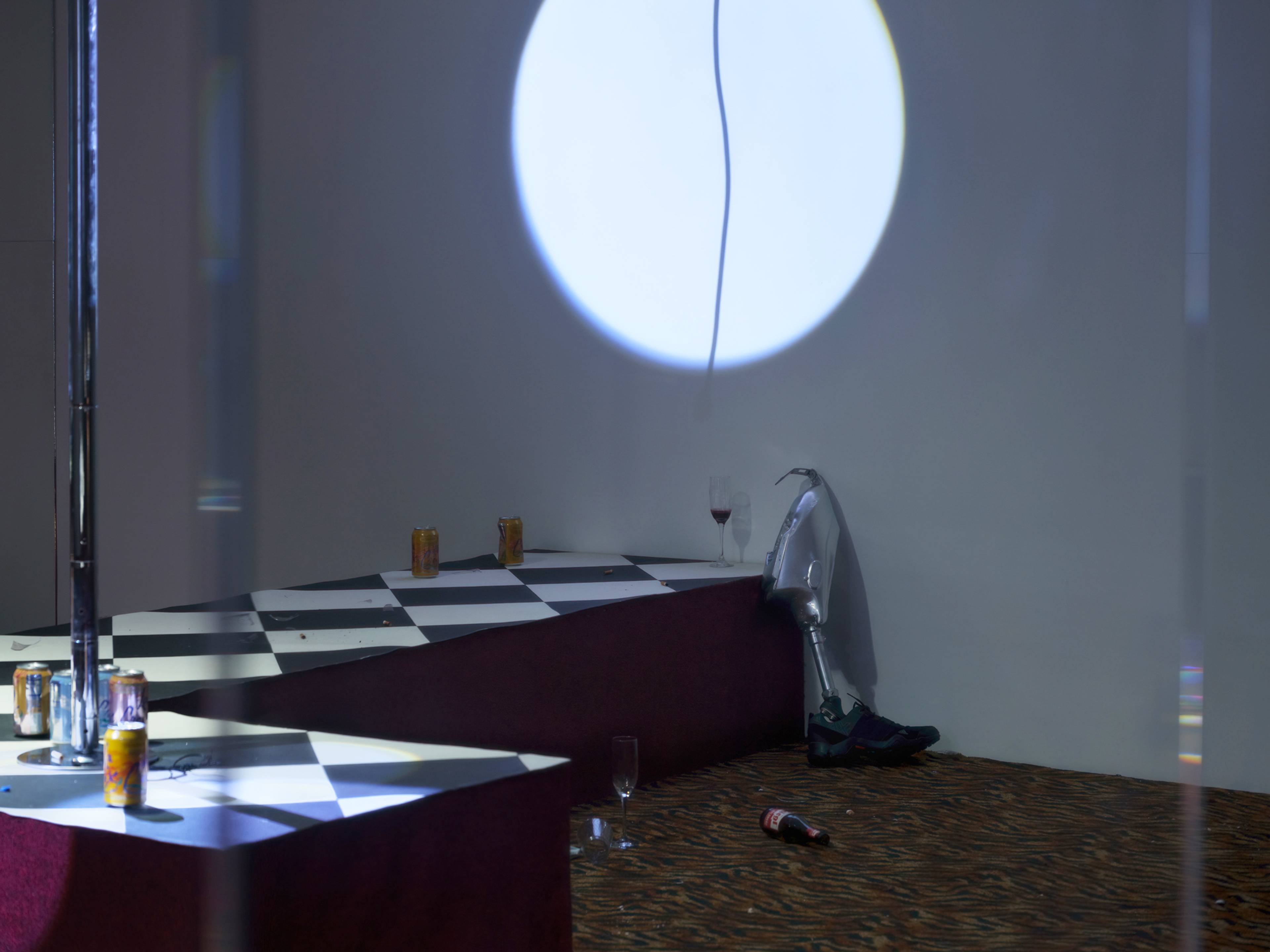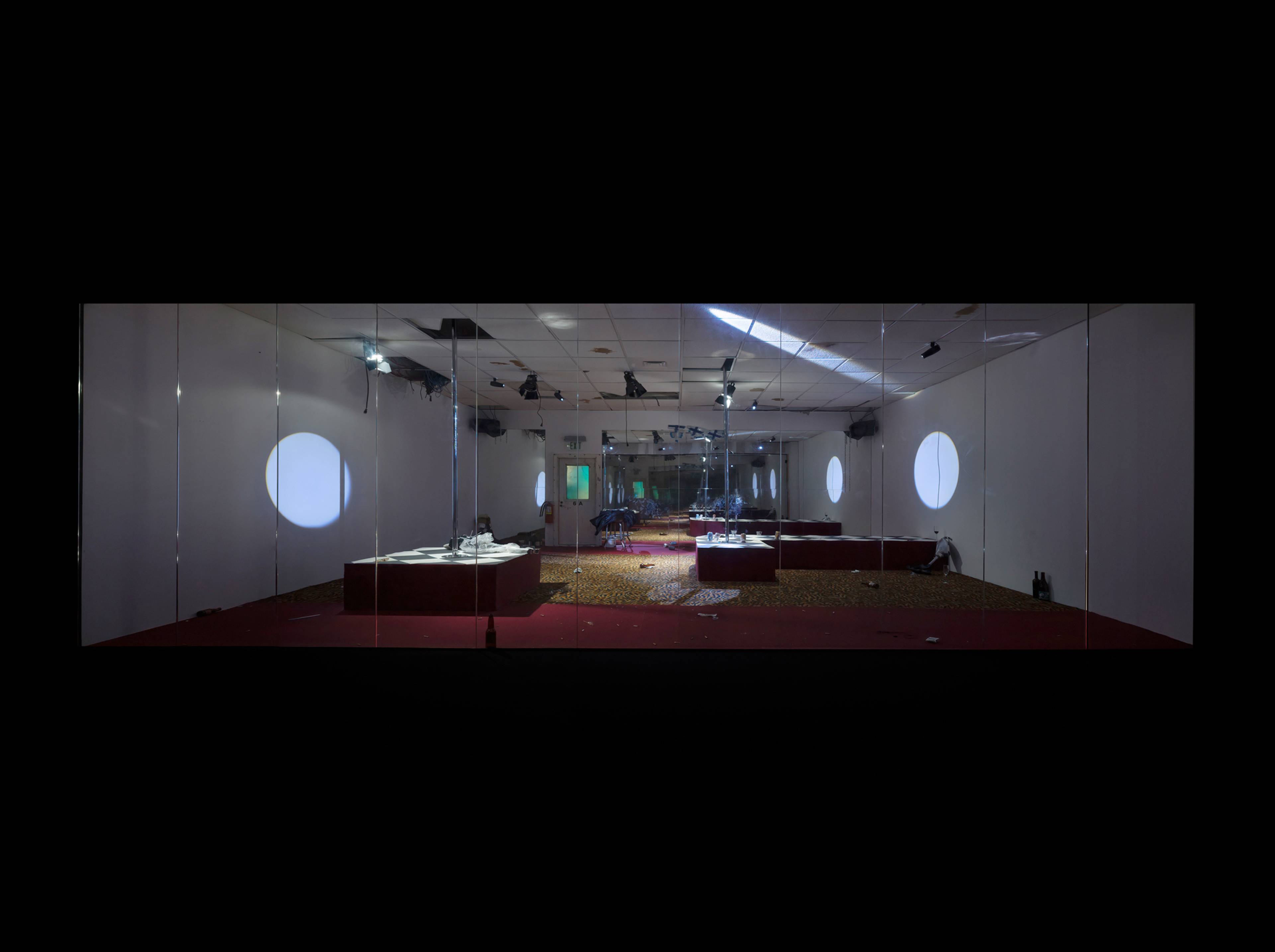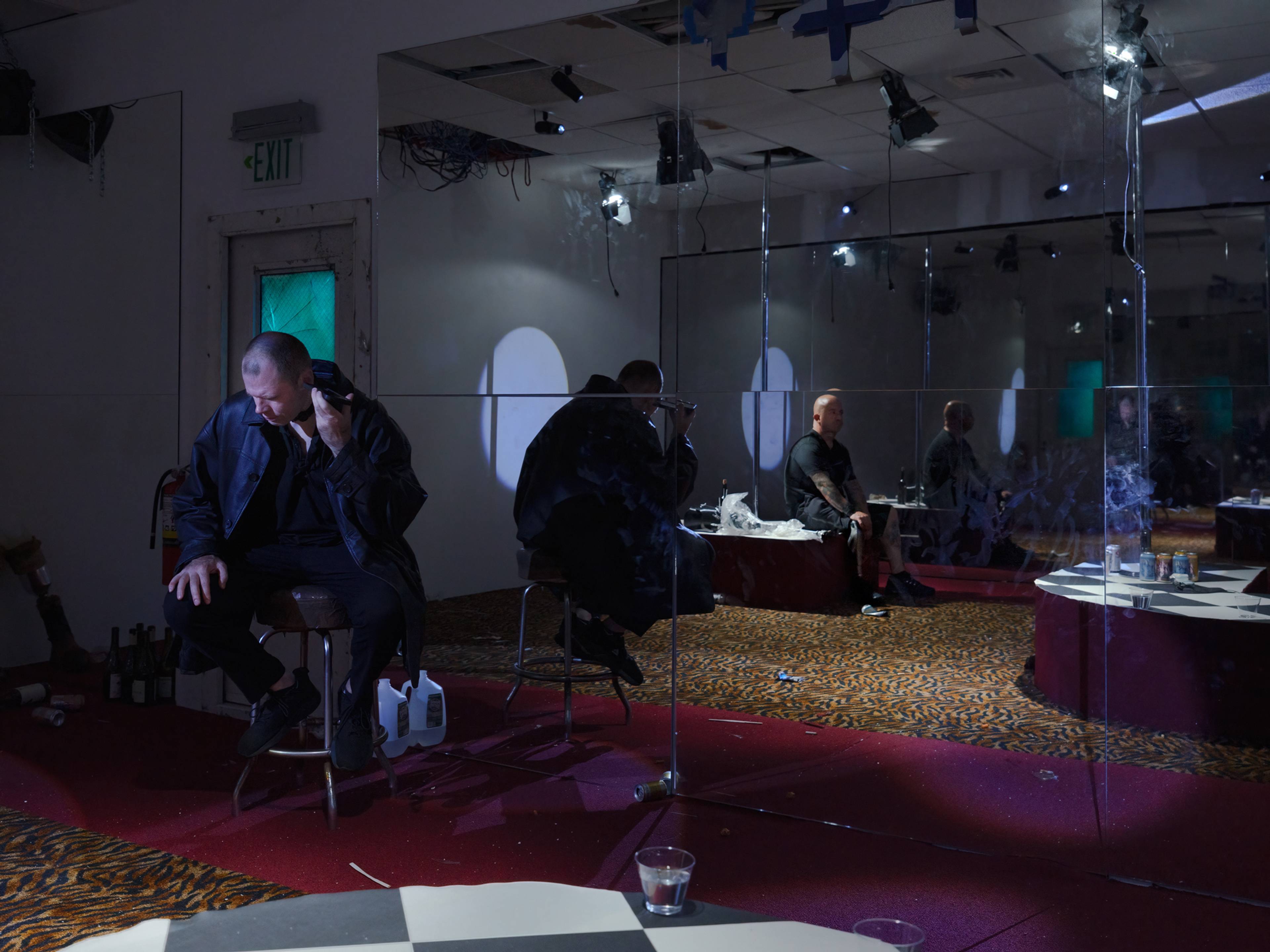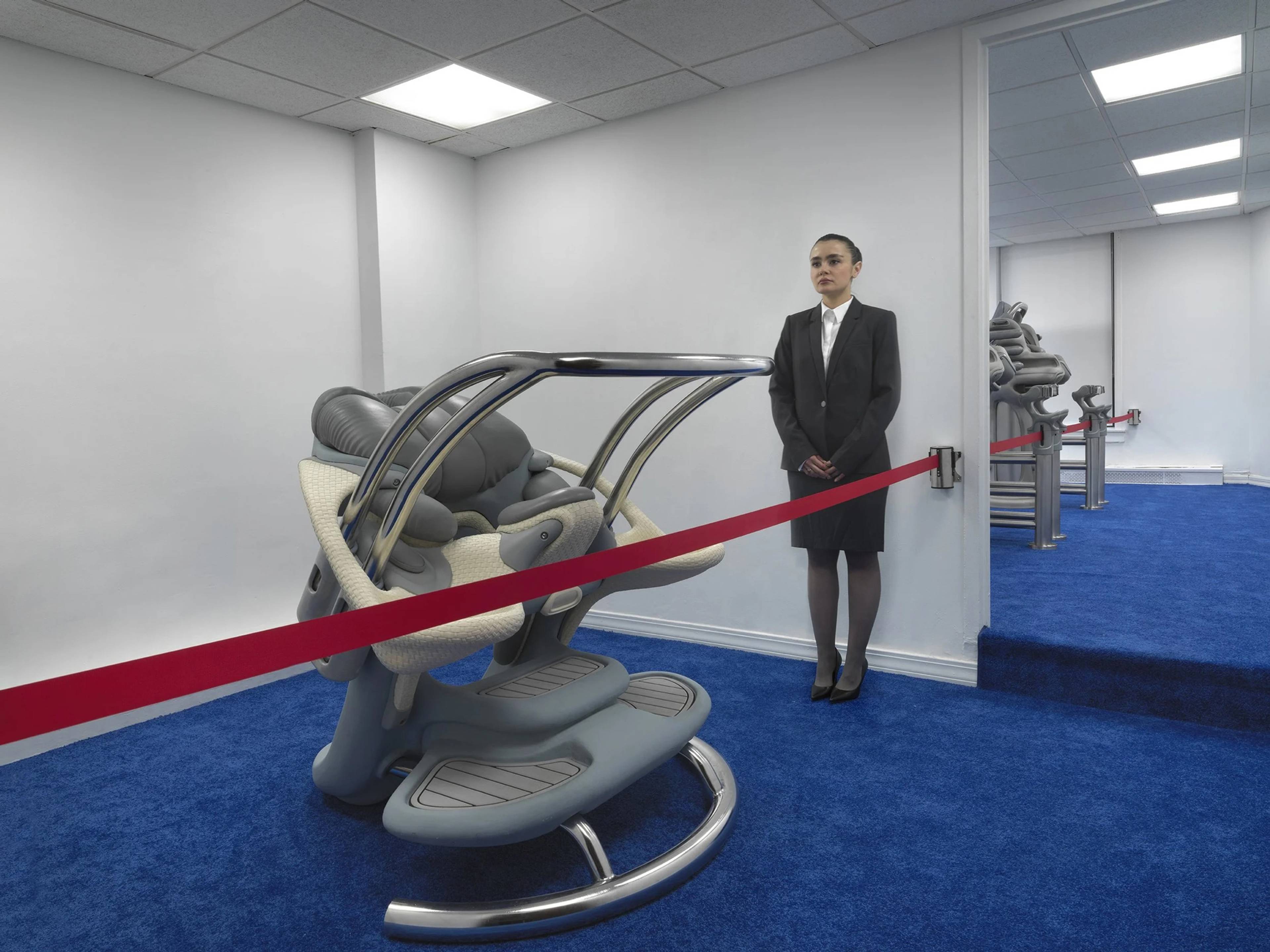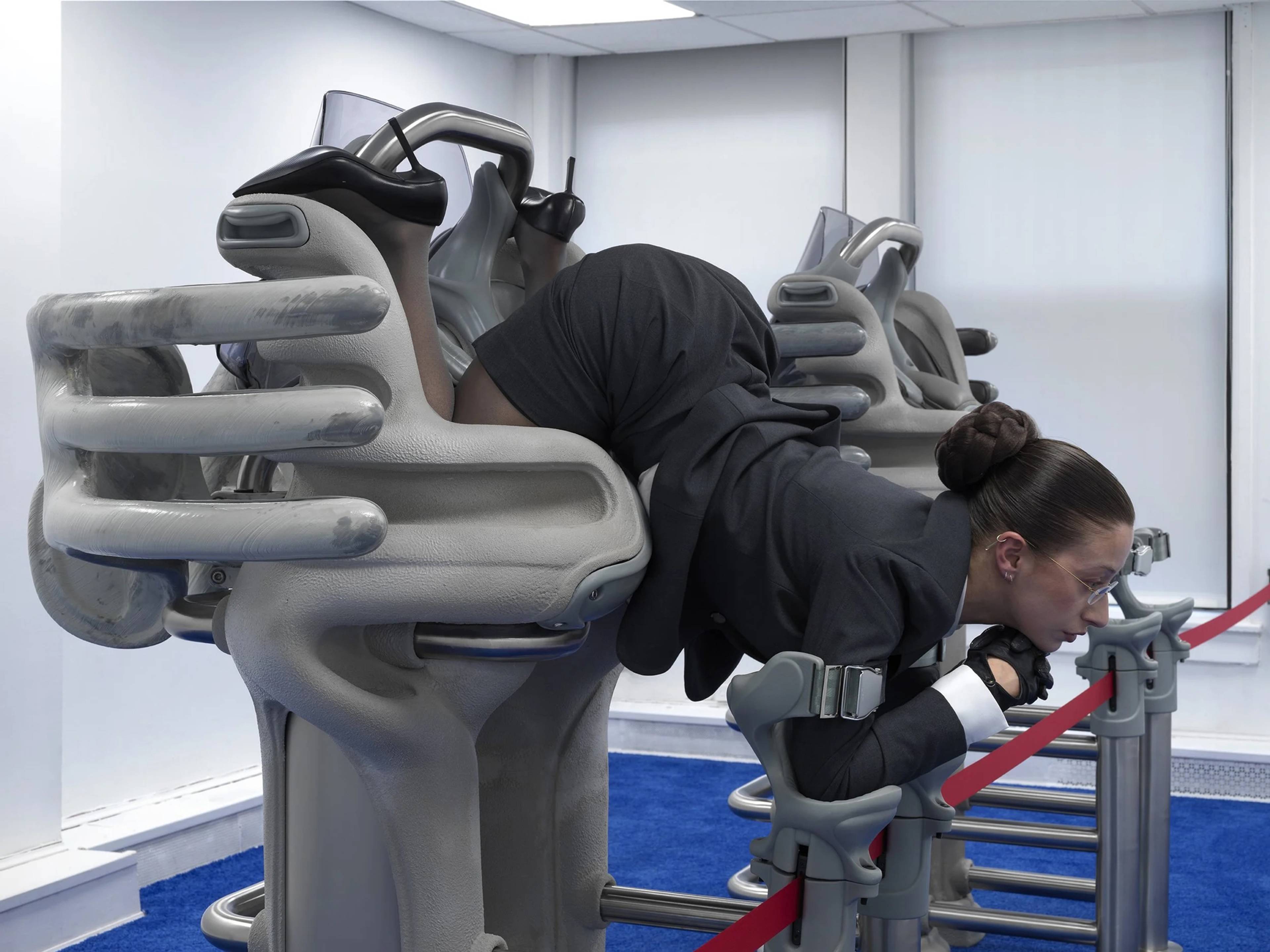The invitation said that Russian-born, New York-based artist Vladislav Markov had built a replica strip club, and that there would be performers. Visitors would watch these performers through one-way mirrors, seeing but not seen. Also, the performers would be amputees.
What a grim exercise in exploitation, I thought. It might be so fucked that it’s good. Plus, curator Nicolas Bourriaud, of relational aesthetics fame, had written a fawning exhibition text (Management, New York). Maybe I’d learn a bit about technology and voyeurism and the death of intimacy by screen.
Reader, these noble hopes were dashed. At the opening, I saw but one woman: the gallerist’s wife. The performers were men. And not male dancers, either, but two stocky bouncer types, dressed as if for winter. Were the girls in the wings? No, there were no girls.
But the realism was impressive. Not just in the sense of the textures of the mise en scène – two poles and stages, empties and cigarette butts and rubles strewn around – but the performers seemed genuinely bored. Club music and fake commercials, mimicking the sassy, stereotyped radio in Grand Theft Auto (1997–), pounded from speakers mounted just below the skewed tiles of a grungy drop ceiling. The men wore earplugs. One of them sat on a stool beside a faux door and an unlit exit sign, green glowing through the glass. He held his phone up to his ear, straining to hear what looked like sports, like half the doormen in the world. The other ambled around the room behind the panes of glass, shuffling over the sleazy tiger-print carpet. He stared at the wall for a while, then sat down on one of the stages, whipped out his phone, and started scrolling. Sure enough, one of his legs flashed metal.
Views of Vladislav Markov, “OBJECTS IN MIRROR MAY BE CLOSER THAN THEY APPEAR,” Management, New York, 2025. Courtesy: the artist and Management, New York. Photos: Inna Svyatsky / installshots.art
The special blend of trash and pity and titillation I expect from a gentleman’s club was there, too, only transferred onto these two guys, shut in a room two or three hours at a stretch for our viewing pleasure. Why were they doing this? For love? For money? This little cycle of patronizing sympathy tumbled around the other male viewers who, it being the preview, couldn’t know what to expect, as if to say: “Yes, I’m here looking. But I want you to know I know, I’m here on a meta mission …” The one-way mirror had a screenlike effect. There was no way to connect with the talent.
The strip joint minus strippers reminded me of wet-look soldier videos, a very niche genre of erotica where buff, geared-up men slowly, slowly enter pools or tubs. It made me think of war between battles, the interminable boredom punctuated by ferocious death.
Amputated lower legs are the war wounds of our time. Among soldiers, at least. US troops who survived attacks by improvised explosive devices in Iraq and Afghanistan often came home with new feet. It’s a generational trauma. I have a friend who was born with one leg, and wears a prosthetic. He’s the right age to have fought in those invasions, but he’s not a veteran. Once in a while, a stranger will thank him for his service. He used to correct them, but not any more – the truth is too awkward.
The prosthetics read as war wounds. The whole room does, really. It’s a kind of ward for a traumatized underclass: military-age and/or middle-age men sent to kill or be killed, then left to rot.
I don’t know how the two performers lost their limbs, although it certainly could’ve been during the decades-long war on terror. Within the Russified fantasy realm of this strip club, it could have been Ukraine. The prosthetics read as war wounds. The whole room does, really. It’s a kind of ward for a traumatized underclass: military-age and/or middle-age men sent to kill or be killed, then left to rot.
Masculinity through war is a cliché, but one we haven’t kicked. Here in the US, our fearless Secretary of Defense thinks women serving in the military is “woke,” and likes to quote an unnamed, possibly apocryphal Vietnam vet, who told him: “Whatever you do, don’t miss your war.” Plenty of soldiers join up out of duty, but the culture around enlistment often smacks of male insecurity. War makes you a man? In 2025? Tell that to Hailey Lujan. But what does the warfighter do when he doesn’t die, but can’t fight? The struggle becomes psychic, an interior reprise of the virtual reality of modern warfare, so called, with drones and “smart bombs” and daily pictures of atrocities in Gaza, the interpolation of screen killing and real death.
Maybe this has to do with the uptick in a particularly grisly subgenre of pornography (per Rule 34: If it exists, there will be porn of it): AI-generated imagery of quadruple-amputee women. This is not the healthy pleasure of consenting adults who happen to be missing limbs. In these images, to paraphrase activist and porn critic Andrea Dworkin, your waifu is pared down to curves and holes. Dworkin famously observed that men are afraid women will laugh at them, while women are afraid men will kill them. A good chunk of the violent fantasies collected online corroborates this. It also supports another truism, that after the demigod-like hype burns off, AI will be a porn engine.
In 2023, I viewed an odd “intimate performance” by artist Anna Uddenberg called Continental Breakfast (Meredith Rosen Gallery, New York), where severe women in tight gray skirts, stockings, and heels were buckled into fetish-y chrome and rubber “chairs” that looked a little bit like mechanized battle suits. The sculptures forced their legs apart or asses up, and the audience lined the wall behind stanchions, slowly shuffling around these structures, as other models did crowd control. The feminism of the performance was a little blunt (as with the first Uddenberg work I saw, in the 9th Berlin Biennale (2016): a mannequin holding a phone up to her butt with a selfie stick). But, as with Markov’s dead club, the light sadomasochism, more tension than release, was effective. The women are strapped in place and the audience is getting a show, but also the women are in control, and the artist is the puppet mistress of the whole thing. In other words, nobody wins.
Anna Uddenberg, Continental Breakfast, 2023. Installation/performance views, Meredith Rosen Gallery, New York, 2023. Photos: Dario Lasagni
Not too long ago, performance art seemed dedicated to breaking through the audience-performer divide. Meals and “immersive” lectures were popular. Clearly, Bourriaud has been paying attention to the last two decades of globalism. When he curated the 15th Gwangju Bienniale (2024), he included paintings by Markov that resemble vague equipment collaged together from overprocessed scans. Performance art, too, seems more interested in alienation and impotence. Instead of free soup and artificial sunsets, a younger generation of artists favor a thuggish virtuality.
Increasingly, “the algorithm” doesn’t give you what you ask for. Instead, you’re presented with what it’s programmed to give you, which is cheaply produced extremism. It’s like the whole world is a strip club with the lights on, but also an escape room, and the only door is fake. You’re just there to watch, you tell yourself. Are you getting what you want? No, you’re not even getting what you’ve been told you want. Instead, you’re trapped in the room, too, trying to be in on the joke, eking some little pleasure out of being tricked.
___


